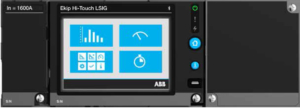Power circuit breaker ratings explained
Darryl Moser
Sales Enablement Manager
ABB Electrification Products Division
When selecting the right low voltage power circuit breaker for an application, it is important to consider both short-circuit current ratings and short-time current ratings. Understanding these performance characteristics will help you choose between the various circuit breaker designs.
A circuit breaker is selected based on its electrical ratings to serve a particular purpose in each application, proper selection of the circuit breaker is essential for the safe and correct operation of the electrical system. Two important ratings to consider are; short-circuit current rating (this is commonly referred to as the maximum interrupting rating) and the short-time current rating. In this post, we will discuss these circuit breaker ratings and how they can affect the protection and selective coordination of the system.
Short-circuit current ratings defined
The short-circuit current rating is the maximum short circuit current that the circuit breaker is rated to safely interrupt at a specific maximum voltage. This short-circuit current rating is normally expressed in rms symmetrical amperes and is specified by the current magnitude only. If a circuit breaker is provided with instantaneous phase trip elements, the interrupting capacity is the maximum rating of the device with no intentional delay. If the circuit breaker is provided without instantaneous phase trip elements, or if the instantaneous phase trip elements can be disabled by the user, the interrupting capacity is the maximum rating of the device for the rated time interval. An engineer can safely apply a circuit breaker in a power system where the available short-circuit fault current on the supply side terminals does not exceed its maximum interrupting rating.
Short-time current ratings defined
The short-time current rating of a circuit breaker is the ability of the circuit breaker to withstand the effects of the rated short-time current level over defined time duration. It demonstrates the ability of the breaker to remain closed for a time interval under high fault current conditions. The short-time current rating is used by the engineer to determine the ability of the circuit breaker to protect itself and to coordinate with other circuit breakers so the system will trip selectively.
Switchgear ratings
Users of low-voltage switchgear commonly use the phrase “bus bracing” to refer to the mechanical strength of the bus bar system in the equipment, but when you look into the standards you will not find “bus bracing” defined or listed as a rating. The product standards applicable to Metal-Enclosed Power Circuit Breaker Switchgear are IEEE C37.20.10 for definitions and IEEE C37.20.1-2018 and C37.51-
2018 for the ratings; [1] [2] [4].
“Rated short-circuit withstand current: The maximum rms current that a circuit can carry momentarily without electrical, thermal, or mechanical damage or permanent deformation. The current shall be the rms value, including the dc component, at the major peak of the maximum offset phase as determined from the envelope of the current wave during a given test time interval.” [1]
For ratings, reference IEEE C37.20.1 – 2015, IEEE Standard for Metal-Enclosed Low-Voltage (1000 Vac and below, 3200 Vdc and below) Power Circuit Breaker Switchgear. [2]
Rated short-circuit withstand current, which is the rated symmetrical short-circuit current that the switchgear bus must be able to withstand for a time duration of at least four electrical cycles, 0.067 seconds on a 60 Hz system. During this test the voltage must be at the maximum rated value such as 635V as opposed to a nominal value of 600V and it must be at a power factor of 15% or lower which translates into a peak current of at least 2.3 times the rms value.
The test to verify rated short-time withstand current in low-voltage metal enclosed switchgear is conducted by applying the short-time current level for two periods of one-half second (30 cycles), separated by a fifteen second interval with no current; or, at the option of the switchgear manufacturer, the test can be performed as a single test of one full second (60 cycles).
Circuit breaker ratings
 These switchgear bus ratings relate directly to the tests and ratings of the low-voltage power circuit breakers (LVPCBs) that are used in the switchgear assembly. For example, the short-time current rating of the switchgear corresponds directly to the rated short-time current testing requirement for unfused power circuit breakers in ANSI C37.50 – 2018, reference clause 3.10.1. [3]
These switchgear bus ratings relate directly to the tests and ratings of the low-voltage power circuit breakers (LVPCBs) that are used in the switchgear assembly. For example, the short-time current rating of the switchgear corresponds directly to the rated short-time current testing requirement for unfused power circuit breakers in ANSI C37.50 – 2018, reference clause 3.10.1. [3]
The rated short-time current in LVPCBs is a rating given to non-automatic circuit breakers, those without trip units, and for non-fused automatic circuit breakers.
Note: Rated short-time withstand current is not applicable to fused circuit breakers as the fuse will open prematurely and not allow the current to flow for the full duration of the rated short-time withstand test.
Trip units
 Low-voltage power circuit breakers have a 30 cycle short-time current rating consistent with the ANSI C37.50 and UL 1066 standards [3] [5]. This allows them to be used without an instantaneous trip element. The interrupting capacity rating of an LVPCB is the rating of the circuit breaker with the instantaneous trip element activated or enabled. Anyone who applies a LVPCB without instantaneous trip elements would need to ensure that the short-time current rating of the device is greater than or equal to the available short-circuit fault current.
Low-voltage power circuit breakers have a 30 cycle short-time current rating consistent with the ANSI C37.50 and UL 1066 standards [3] [5]. This allows them to be used without an instantaneous trip element. The interrupting capacity rating of an LVPCB is the rating of the circuit breaker with the instantaneous trip element activated or enabled. Anyone who applies a LVPCB without instantaneous trip elements would need to ensure that the short-time current rating of the device is greater than or equal to the available short-circuit fault current.
Modern electronic trip units allow for maximum time-current curve shaping which helps you to selectively coordinate with other circuit breakers. These trip units are designed with adjustments for long-time pickup threshold and time delay, shorttime pickup threshold and time delay, instantaneous pickup, and ground fault pickup threshold and time delay.
Protection and coordination
Equipment protection and coordination can be competing objectives of the system designer, when applied within their electrical ratings circuit breakers will safely protect both themselves and the electrical system. Selective coordination is necessary when continuity of service is desired. This is often achieved through the use of the circuit breaker’s short-time ratings. An intentional tripping delay may be applied only when downstream circuit breakers have an adequate short-time current rating or are self-protecting.
For many applications in low-voltage power distribution systems, a lesser short-time current rating may be acceptable; but, for applications such as a main circuit breaker in a service entrance switchboard or switchgear, it may not be. A low-voltage power circuit breaker used as a main circuit breaker that has a 65 kA short-time current rating would allow the flexibility to coordinate with downstream circuit breakers for a fault of any magnitude up to the full 65 kA short circuit current rating of the circuit breakers and switchgear.
Conclusion
Proper selection of LVPCBs is critical to the performance of the electrical system. Choosing circuit breakers with an appropriate short-circuit current rating and short-time current rating provides the opportunity to have a selectively coordinated system up to high fault current levels.
Emax 2 Circuit Breaker Ratings

References
[1] IEEE C37.20.10 – 2016, IEEE Standard Definitions for AC (52 kV and below) and DC (3.2 kV and below) Switchgear Assemblies
[2] IEEE C37.20.1 – 2015, IEEE Standard for Metal-Enclosed Low-Voltage (1000 Vac and below, 3200 Vdc and below) Power Circuit Breaker Switchgear
[3] ANSI C37.50 – 2018, Low Voltage AC Power Circuit Breakers Used in Enclosures— Test Procedures
[4] ANSI C37.51 – 2018, Metal-Enclosed Low-Voltage AC Power Circuit Breaker Switchgear Assemblies— Conformance Test Procedures
[5] UL 1066, Fourth Edition, Low-Voltage AC and DC Power Circuit Breakers Used in Enclosures
Related Content
Check out more on power circuit breakers: Emax 2 circuit breakers on ABB website




